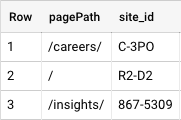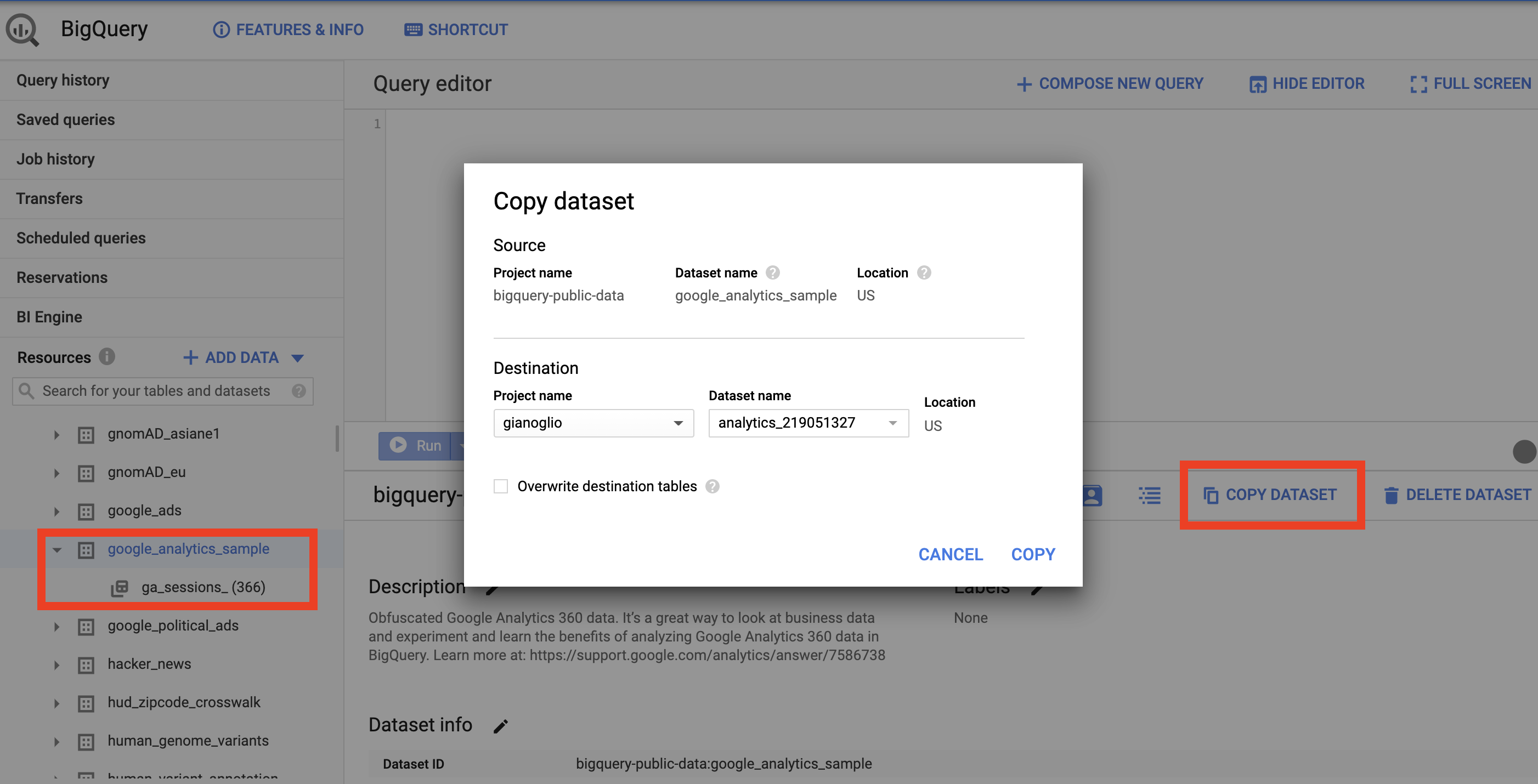Updating Google Analytics Hit-Level Custom Dimensions in BigQuery
Updating hit-level custom dimension information in BigQuery is not as simple as it sounds. Here's the code to do it.

I recently had a client with a problem. There was an issue with their Google Tag Manager implementation that prevented the collection of certain hit-level custom dimensions to Google Analytics.
Fortunately, they had GA360 (with the export to BigQuery already enabled), and the missing custom dimension information was able to be replicated based on the page path. In other words, I could create a lookup table table based on the page path of the hit to grab the corresponding custom dimension value (in this particular case, it was a custom dimension named Site ID).
It seemed simple enough. But it turned out to be rather complex. (If you know of a simpler soultion, please let me know! I do sometimes have a tendency to find overly complicated solutions.)
The complexity stems from the fact that these are hit-level custom dimensions, requiring me to have to UNNEST two levels deep (UNNEST the hits, then UNNEST the custom dimensions).
Also, I wanted to use the BigQuery data manipulation language (DML) to do the updates - mainly because I haven’t had a chance to really use it before and also because it seemed appropriate for the task.
With DML, you can update, insert, and delete data from your tables. I needed to update the tables, but specifically, I needed to update the hits field. Due to the nested nature of the Google Analytics data in BigQuery, the hits field is a single column (comprised of 176 other “sub-fields”!).
I thought I’d be able to update just part of the hit (specifically, the value for custom dimension index 1). However, almost every method I tried ended in the following error:
Error: Correlated subqueries that reference other tables are not supported unless they can be de-correlated, such as by transforming them into an efficient JOIN.
After spending too many hours on Stack Overflow, reading BigQuery documentation on ARRAY and STRUCT, and experimenting with different queries, I came to the realization that I’d just have to UNNEST the hits and the hits.customDimensions, join on the lookup table table, then recreate the the entire hits field for each session. Fun.
For those that want to follow along, below is the SQL to generate a couple rows to mimic Google Analytics data in BQ. This is a simpler dataset to work with, which I found helps when trying to tackle larger problems.
-- Create a table to mimic a session in GA
SELECT
'1234' AS clientId,
12345678 AS visitStartTime,
STRUCT(1 AS visits,
2 AS hits) AS totals,
[ STRUCT(1 AS hitNumber,
STRUCT('/careers/' AS pagePath,
'example.com' AS hostname) AS page,
[STRUCT(1 AS index,
'one' AS value),
STRUCT(2 AS index,
'two' AS value)] AS customDimensions),
STRUCT(2 AS hitNumber,
STRUCT('/insights/' AS pagePath,
'example.com' AS hostname) AS page,
[STRUCT(1 AS index,
'(not set)' AS value),
STRUCT(2 AS index,
'two-more' AS value)] AS customDimensions) ] AS hits
UNION ALL
SELECT
'9877' AS clientId,
23456789 AS visitStartTime,
STRUCT(1 AS visits,
3 AS hits) AS totals,
[ STRUCT(1 AS hitNumber,
STRUCT('/' AS pagePath,
'example2.com' AS hostname) AS page,
[STRUCT(1 AS index,
'one' AS value),
STRUCT(2 AS index,
'two' AS value)] AS customDimensions),
STRUCT(2 AS hitNumber,
STRUCT('/blog/' AS pagePath,
'example2.com' AS hostname) AS page,
[STRUCT(2 AS index,
'dos' AS value)] AS customDimensions),
STRUCT(3 AS hitNumber,
STRUCT('/blog/post/' AS pagePath,
'example2.com' AS hostname) AS page,
[STRUCT(1 AS index,
'un' AS value),
STRUCT(2 AS index,
'deux' AS value)] AS customDimensions) ] AS hits
The above SQL will ouput two rows, with nested hits and nested custom dimensions.
Notice in the screenshot above how the second hit of the first row (with a hits.page.pagePath of /insights/) has a value of (not set) for custom dimension index 1. The goal is to update that value from (not set) to a value based on a separate lookup table table.
The following SQL outputs our sample lookup table table:
-- Create a table to mimic a lookup table table with pagePath and site ID
SELECT
'/careers/' AS pagePath,
'C-3PO' AS site_id
UNION ALL
SELECT
'/' AS pagePath,
'R2-D2' AS site_id
UNION ALL
SELECT
'/insights/' AS pagePath,
'867-5309' AS site_id
This is our lookup table table. Whenever custom dimension index 1 has a value of (not set), we’ll replace that with the value in this table, based on the page path of the hit.
Given the sample table generated by the first bit of SQL, we see that the second hit of the first session has a value of (not set) for custom dimension index 1 and a hits.page.pagePath of /insights/. So we’d join with the lookup table table where hits.page.pagePath = pagePath, and replace (not set) with 867-5309 - the value of the site_id field in the lookup table table.
To follow along with this example, run the queries above and save the results as tables. I named them ga_sessions_sample and site_id_lookup, which I’ll reference throughout the rest of this article.
Time to Transform
Now that we’ve set up some sample tables, it’s time to get to work. There are basically 2 steps that need to happen:
Step 1: Create an “updated hits” table with clientId, visitStartTime, and the entire hits field (with the custom dimension value updated). This will be the table that we use to replace the hits field in the original ga_sessions_* tables.
Step 2: Run through the DML to update the hits field in the ga_sessions_* tables with the hits in our updated table.
Step 1
This query will update every instance of custom dimension Index 1 where the value is (not set), using the lookup table table to replace (not set) with the site_id value. Run this query and save the output to a table (I named this table updated_hits)
-- t1 UNNESTs the table and joins on the lookup table to get the correct value for Site ID
WITH t1 AS (
SELECT
clientId
, visitStartTime
, hits
, cd.index
, IF(cd.index = 1 AND cd.value = '(not set)', site_id, cd.value) AS value
FROM
`PROJECT.DATASET.ga_sessions_sample` AS sessions, UNNEST(hits) AS hits, UNNEST(hits.customDimensions) AS cd
LEFT JOIN `PROJECT.DATASET.site_id_lookup` AS site_id_lookup
ON hits.page.pagePath = site_id_lookup.pagePath
),
-- t2 puts the CD index and value into an array of structs, and selects all other fields
t2 AS (
SELECT
* EXCEPT(hits, index, value)
, hits.hitNumber
, ANY_VALUE(hits.page) AS page
, ARRAY_AGG(STRUCT(index, value)) AS customDimensions
FROM t1
GROUP BY clientId, visitStartTime, hitNumber
ORDER BY clientId, visitStartTime, hitNumber ASC
)
-- forms all the hit fields into an array of structs
SELECT
clientId
, visitStartTime
, ARRAY_AGG(STRUCT(hitNumber, page, customDimensions)) AS hits
FROM
t2
GROUP BY
clientId, visitStartTime
This is our updated hits table. It includes just the clientId, visitStartTime, and hits fields (with the updated custom dimension value).
Now that you have a table with the clientId and visitStartTime (which we use to uniquely identify a session), along with the updated hits field for that session (which includes the updated custom dimension value), all that’s left is a simple DML script to update the original ga_sessions_sample table:
UPDATE
`PROJECT.DATASET.ga_sessions_sample` AS a
SET a.hits = b.hits
FROM
`PROJECT.DATASET.updated_hits` AS b
WHERE
a.clientId = b.clientId AND a.visitStartTime = b.visitStartTimeAfter running the above script, check your ga_sessions_sample table again. You should see something like below:

This is our updated ga_sessions_sample table. It includes all of the original fields, with the updated custom dimension value outlined in red).
Play Time’s Over
Now that we have the proof of concept working on a sample dataset, it’s time to apply the same principles (and make some slight modifications) to work with multiple days of real GA data.
Here’s the SQL to update and recreate the entire hits record:
-- t1 UNNESTs the table and joins on the lookup table to get the correct value for SiteID
WITH t1 AS (
SELECT
clientId
, visitStartTime
, hits
, cd.index
, CASE
WHEN cd.index = 1 AND cd.value = '(not set)' THEN site_id
ELSE cd.value
END AS value
FROM
`PROJECT.DATASET.ga_sessions_*` AS sessions, UNNEST(hits) AS hits, UNNEST(hits.customDimensions) AS cd
LEFT JOIN `PROJECT.DATASET.site_id_lookup` AS lookup_table
ON lookup_table.pagePath = hits.page.pagePath
WHERE
_TABLE_SUFFIX BETWEEN '20201001' AND '20201007'
),
-- t2 puts the CD index and value into an array of structs, and selects all other fields
t2 AS (
SELECT
* EXCEPT(hits, index, value)
, hits.* EXCEPT(page
, customDimensions
, transaction
, item
, contentInfo
, appInfo
, exceptionInfo
, eventInfo
, product
, promotion
, promotionActionInfo
, refund
, eCommerceAction
, experiment
, publisher
, customVariables
, customMetrics
, social
, latencyTracking
, sourcePropertyInfo
, contentGroup
, publisher_infos)
, ANY_VALUE(hits.page) AS page
, ANY_VALUE(hits.transaction) AS transaction
, ANY_VALUE(hits.item) AS item
, ANY_VALUE(hits.contentInfo) AS contentInfo
, ANY_VALUE(hits.appInfo) AS appInfo
, ANY_VALUE(hits.exceptionInfo) AS exceptionInfo
, ANY_VALUE(hits.eventInfo) AS eventInfo
, ANY_VALUE(hits.product) AS product
, ANY_VALUE(hits.promotion) AS promotion
, ANY_VALUE(hits.promotionActionInfo) AS promotionActionInfo
, ANY_VALUE(hits.refund) AS refund
, ANY_VALUE(hits.ecommerceAction) AS ecommerceAction
, ANY_VALUE(hits.experiment) AS experiment
, ANY_VALUE(hits.publisher) AS publisher
, ANY_VALUE(hits.customVariables) AS customVariables
, ANY_VALUE(hits.customMetrics) AS customMetrics
, ANY_VALUE(hits.social) AS social
, ANY_VALUE(hits.latencyTracking) AS latencyTracking
, ANY_VALUE(hits.sourcePropertyInfo) AS sourcePropertyInfo
, ANY_VALUE(hits.contentGroup) AS contentGroup
, ANY_VALUE(hits.publisher_infos) AS publisher_infos
, ARRAY_AGG(STRUCT(index, value)) AS customDimensions
FROM t1
GROUP BY 1,2,3,4,5,6,7,8,9,10,11,12,13
ORDER BY clientId, visitStartTime, hitNumber ASC
)
-- forms all the hit fields into an array of structs
SELECT
clientId
, visitStartTime
, ARRAY_AGG(STRUCT(
hitNumber
, time
, hour
, minute
, isSecure
, isInteraction
, isEntrance
, isExit
, referer
, page
, transaction
, item
, contentInfo
, appInfo
, exceptionInfo
, eventInfo
, product
, promotion
, promotionActionInfo
, refund
, ecommerceAction
, experiment
, publisher
, customVariables
, customDimensions
, customMetrics
, type
, social
, latencyTracking
, sourcePropertyInfo
, contentGroup
, dataSource
, publisher_infos)) AS hits
FROM
t2
GROUP BY
clientId, visitStartTime114 lines of SQL isn’t bad, considering there are 176 different fields all nested within the hits record.
Running the above script will output the “updated_hits,” with the clientID, visitStartTime, and (updated) hits fields. This is what we did in Step 1 above. Again, you’ll want to save the output of this query to a table (I named it updated_hits).
Unfortunately, if your date range is too long or if you have a lot of data, the above query will produce the following error:
Uh oh - looks like we got a little crazy with our query and BQ can’t handle it!
This is the result of several computationally expensive operations, starting with the multiple UNNESTs in the first common table expression (CTE), followed by horrendous 1-2 punch of a 13-field GROUP BY and 3-field ORDER BY - ouch!
I haven’t found an elegant solution around this yet, and I had a bit of a time crunch to get this out for the client. So I’m somewhat ashamed to admit that I just brute-forced my way through this by shortening the date range (to no more than 3 days as a time) and kept running this query over and over again (for about an hour and a half). I was appending the results to a single “updated hits” table each time. I’m not proud.
Fortunately, once I suffered through the manual updates, the rest was easily automated. I just repurposed the DML statement from above and sprinkled in some variables and a WHILE loop. This way, it loops through each ga_sessions_* table and replaces the hits field from the updated table.
-- Update the first 7 variables to reflect your project, dataset, and table names and the
-- start and end dates of the tables you want to update.
DECLARE original_ga_sessions_project STRING DEFAULT "PROJECT";
DECLARE original_ga_sessions_dataset STRING DEFAULT "DATASET";
DECLARE updated_table_project STRING DEFAULT "PROJECT";
DECLARE updated_table_dataset STRING DEFAULT "DATASET";
DECLARE updated_table STRING DEFAULT "TABLE_NAME";
DECLARE first_date INT64 DEFAULT 20200625;
DECLARE last_date INT64 DEFAULT 20200627;
-- DO NOT TOUCH ANYTHING BELOW THIS LINE --
DECLARE original_ga_tables_array ARRAY<STRING>;
DECLARE original_ga_table STRING;
DECLARE updated_hits STRING;
DECLARE i INT64 DEFAULT 0;
SET updated_hits = (
SELECT
CONCAT('`', updated_table_project, '.', updated_table_dataset, '.', updated_table, '`')
);
SET original_ga_tables_array = (
WITH date_array AS (
SELECT
GENERATE_ARRAY(first_date, last_date) AS dates
)
SELECT
ARRAY_AGG(CONCAT(original_ga_sessions_project, '.', original_ga_sessions_dataset, '.ga_sessions_', date))
FROM
date_array, UNNEST(dates) AS date
);
WHILE i < ARRAY_LENGTH(original_ga_tables_array) DO
SET original_ga_table = (
SELECT
CONCAT('`', original_ga_tables_array[OFFSET(i)], '`')
);
EXECUTE IMMEDIATE format("""
UPDATE
%s AS a
SET a.hits = b.hits
FROM
%s AS b
WHERE
a.clientId = b.clientId AND a.visitStartTime = b.visitStartTime
""", original_ga_table, updated_hits);
SET i = i + 1;
END WHILE;All you have to do is update the first 7 variables in the above script with your specific project, dataset, and table names, along with the start and end dates of the tables you want to update. Just be ready to wait a while for this script to run if you have a lot of tables to update. In my particular example, it took 1 hour and 3 minutes to update about 3 months' worth of tables.

My new record for longest time to process a query - 1 hour and 3 minutes!
But Jim, what about …
I know, I can already hear the question “I need to update a hit-level custom dimension that isn’t included at all in the data - how do I do that?” That’s a great question. When I worked through the client problem that inspired this post, I was fortunate (I think) that if the custom dimension didn’t have a value in the dataLayer, they were falling back to manually setting the value to (not set).
This makes the update fairly straight forward:
IF(cd.index = 1 AND cd.value = '(not set)', site_id, cd.value) AS value
But if nothing at all is being passed, it gets tricky. I haven’t quite thought through that scenario, but if you’re interested in a solution and willing to buy me a drink at the next in-person conference once the plague lifts, let me know and I’ll figure it out for you.

